Peripheral Nervous System
Table of Contents
What is the Peripheral Nervous System?
The Peripheral Nervous System (PNS) is a vital component of the human nervous system, working in conjunction with the Central Nervous System (CNS) to facilitate communication between the body and the brain. It consists of an intricate network of nerves and ganglia that extend throughout the body, connecting various organs, muscles, and sensory receptors to the CNS.
The primary function of the PNS is to relay information between the body’s internal and external environments and the CNS. It is subdivided into two major components: the sensory (afferent) division and the motor (efferent) division.
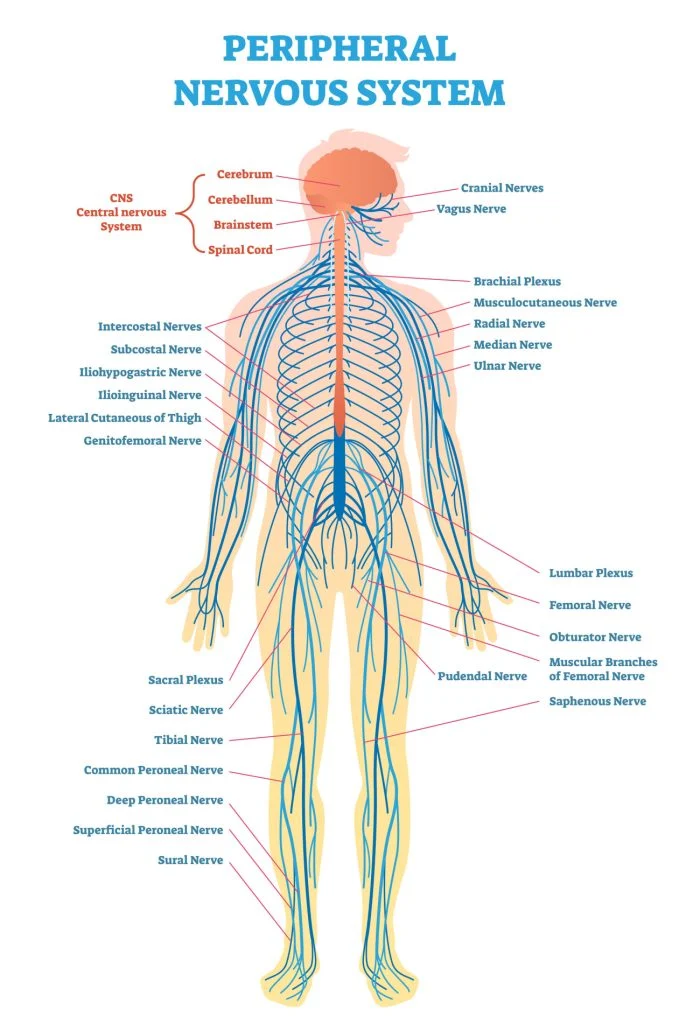
- The central nervous system is connected to the rest of the body through the peripheral nervous system which is an integral part of the nervous system. It consists of a network of nerves and Ganglia that Transmit information between the brain and spinal cord, as well as muscles, organs and Sensory organs.
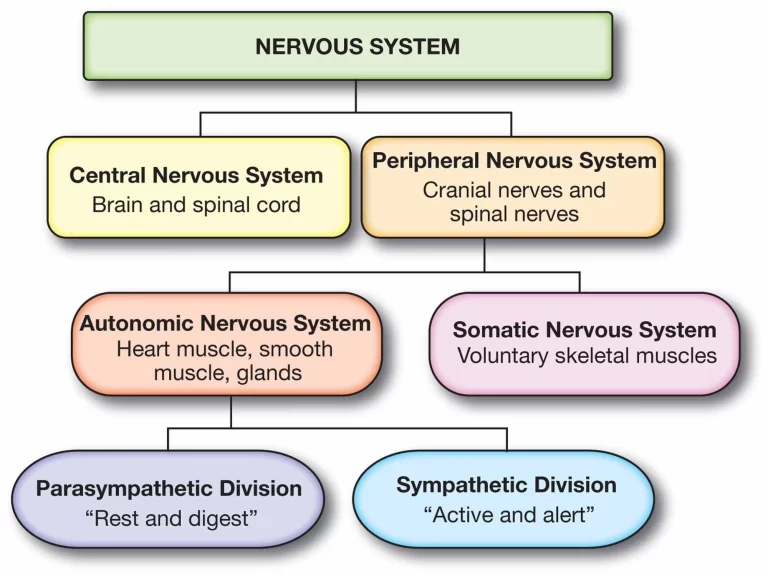
- The 2 main parts of the nervous system are the central nervous system and the peripheral nervous System. The peripheral nervous system consists of a vast network of nerves that connect the brain and Spinal cord to many parts of the body, such as muscles and organs, unlike the central nervous system, Which consists of the brain and spinal cord.
- The main function of the PNS is to provide a central link Between the central nervous system and the skin, limbs, and organs. Our ability to respond to different stimuli allows the brain and spinal cord to have an extensive neural network that allows us to gather Sensory information from the outside and transmit motor instructions to different parts of the body.
The four main purposes of the peripheral nervous system are:
- Autonomic bodily functions are those that occur without conscious effort and are controlled by the PNS. These include heart rate, blood pressure, respiratory rate, and digestion.
- Facilitates motor movements: Sends messages from the central nervous system to the muscles, allowing us to walk, talk, grasp objects, And perform other actions.
- Control of the digestive tract: The PNS controls the release of digestive enzymes, Gastric motility and other processes necessary for efficient digestion and absorption of nutrients.
- It acts as a Link between the outside world and the central nervous system, transmitting sensory information from the Sense organs (such as the eyes, hearing and skin) to the brain that allows us to experience and understand Our environment.
- Functions of the peripheral nervous system include the pupillary reflex, which causes the Eyes to dilate or close in response to light, triggers the sweat response, regulates blood flow to various Organs and tissues, and regulates the heart rate according to the body’s needs.
- The peripheral nervous system, which constantly facilitates communication between the brain and the rest of The body, is essential for maintaining homeostasis and helps us successfully connect with our environment.
How is PNS done?
Many different types of nerve cells and components make up the peripheral nervous System. This includes both peripheral and cranial nerves, which act as command points and use specialized Neurons to transport and transmit signals through axons and dendrites throughout the nervous system. Let’s Take a closer look at the primary cell types of the peripheral nervous system:
- Neurons:
Neurons are important for transmitting and transmitting electrical and chemical impulses Throughout the nervous system. A neuron consists of several important parts, including:
- The cell body: which contains the essential organelles and genetic material of the neuron, is a structure in The center of the neuron.
- Axon: An extension of the cell body that resembles a long arm. Electrical signals Are converted into chemical signals at synapses at the end of the axon, allowing communication with nearby Neurons.
- Dendrites: These are small branch-like projections that extend from the cell body (their name is Derived from the Latin word for “woody”). Acting as receptors, dendrites receive chemical signals from the Synapses of neighboring neurons.
- Myelin: The axons of many nerve cells are surrounded by a thin protective Covering made of a fatty substance called myelin. The insulating sheath function of myelin accelerates and Improves the efficiency of signal transmission.
The dendrites of a single neuron can form connections with Thousands of additional synapses, demonstrating the amazing complexity of neuronal connections. Neurons Very in length depending on where they are in the body and how they are used.
2. Glial cells
- pronounced “glee-uhl” cells, have various functions throughout life. They are necessary for the Formation, maintenance and growth of nerve cells. These cells also regulate nerve cell activity and protect The brain system against viruses. One of their main functions is to produce the myelin sheath that covers the Axons of nerve cells, increasing their safety.
Structures of the Peripheral Nervous System
The somatic nervous system and the autonomic nervous system, both of which have different and crucial Functions in the overall functioning of the peripheral nervous system, are actually two main parts of the Peripheral nervous system.
The Somatic nervous system
Transmission of sensory and motor information to and from the central nervous system occurs via the Somatic nervous system. Its name is a translation of the Greek word “soma” which means “body”.
There are mainly two types of neurons working in the somatic system:
- Motor neurons: also known as efferent neurons, transmit information from the brain and spinal cord to the Muscle fibers that make up each part of the body,
- Afferent neurons: also known as sensory neurons, are neurons that transmit sensory information from nerves To the central nervous system. By sending information from the outside world to the brain and spinal cord, These neurons allow people to perceive the world around them.
Autonomic nervous system
The autonomic nervous system controls the body’s involuntary processes, such as breathing, heartbeat, Digestion and circulation. This system maintains the continuity of these important tasks without conscious Effort by controlling body systems that normally function without conscious control. In addition, the autonomic Nervous system and can be divided into two parts:
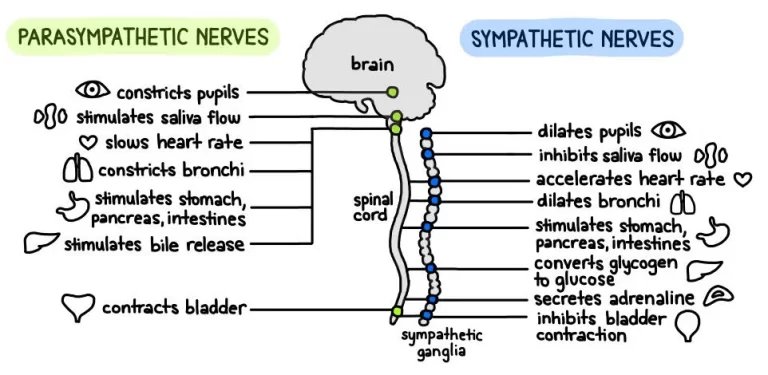
- Sympathetic System: When the body is faced with a potential threat or stress, this branch is responsible for Initiating the “fight or flight” response. It prepares the body to respond by speeding up breathing, directing Blood flow to the muscles, releasing sweat and dilating the pupil, all in preparation for quick action.
- Parasympathetic system: The role Of the parasympathetic system is to keep the body functioning normally and to conserve energy during Sleep. The parasympathetic system slows the heart rate, slows breathing, reduces blood flow to the muscles And constricts the pupil when danger or stress has passed, allowing the body to recover.
Nerves of the peripheral nervous system
General nervous structure
- The peripheral nervous system consists of a network of nerves, ganglia, and plexuses. The axons of several Neurons are connected by connective tissue to form nerves. Thanks to a phospholipid produced by a glial Cell known as a Schwann cell, the axon is often myelinated. This myelin coating acts as an insulator and Speeds up the transmission of nerve signals. The neurilemma or neurolemma, the thin covering of the Schwann cell, acts as the inner protective layer of the axon.
- In neuron anatomy, the endoneurium surrounds The neurilemma and consists of connective tissue, blood capillaries, and other tissues. Fascicles are Bundles of multiple axons held together by connective tissue known as the perineurium. The fibrous Epineurium surrounds the entire nerve, consisting of several axon bundles, and provides additional Protection and support.
- The soma, or cell bodies, of neurons also gather in groups in the nervous system and are protected by the Epineurium, resulting in spots called ganglia. These ganglia play an important role in the synaptic Transmission between two neurons of the autonomic nervous system, which enables the communication Necessary for autonomic function.
Nerves of the PNS The peripheral nervous system consists of the following main nerves:
- Brachial plexus
- Femoral nerve
- Lateral femoral cutaneous nerve
- Peroneal nerve
- Sciatic nerve
- Spinnerva accessory
- Tibial nerve
Spinal nerves
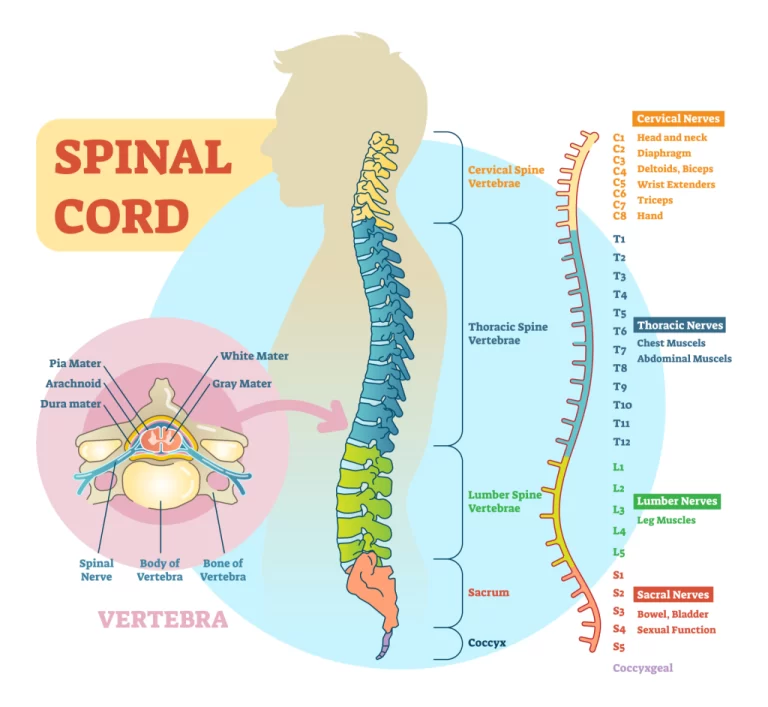
- 31 pairs exit the spinal cord laterally, so spinal nerves are important parts of the peripheral nervous system. There are 8 cervical nerves, 12 thoracic nerves, 5 iliac nerves, 5 sacral nerves, and 1 cochlear nerve Because each pair of spinal nerves is associated with a specific region of the spinal cord.
- The dorsal root and the ventral root contribute to the connection between each spinal cord and the spinal Cord. While motor neurons are found in the gray matter of the spinal cord, the cell bodies of sensory neurons Are located in clusters called dorsal root ganglia. These two roots come together to give rise to the spinal Nerve just before it leaves the vertebra.
- Spinal nerves differ from other types of nerves because they are mixed nerves, meaning they contain both Sensory and motor components. While motor neurons convey signals from the spinal cord to muscles and Glands, enabling movement and other physiological reactions, sensory neurons transfer information from Sense receptors to the spinal cord.
- Our capacity to interact with the environment and react to different stimuli depends on the spinal nerves. We Can accomplish voluntary movements and involuntary processes essential for preserving homeostasis Thanks to their critical role in relaying sensory information to the central nervous system and coordinating Motor orders. Our general functionality and adaptability are influenced by the way these spinal nerves are Organised, which guarantees effective communication between the brain, spinal cord, and the rest of the Body.
Cranial nerves
- All save the vagus nerve exit via the foramina of the skull to innervate structures in the head, neck, and facial Area. 12 pairs of cranial nerves come from the lower surface of the brain.
- Most cranial nerves have both sensory and motor components and are named and numbered according to How they appear on the lower surface of the brain. Special senses such as smell, sight, hearing and balance Are connected by three nerves that carry only sensory fibers. The remaining five nerves are primarily motor, Although they also have proprioceptive sensory fibers. The remaining four nerves consist mainly of motor And sensory fibers.
- The eighth cranial nerve, commonly known as the vestibulocochlear nerve or balance nerve, is one of those Cranial nerves that can sometimes cause benign fibrous tumors known as acoustic neuromas. Because These tumors are benign, they do not spread to other parts of the body. However, because they are located In the brainstem near important brain centers deep inside the skull, this can cause involvement of nearby Structures with important functions. These tumors usually grow slowly over time, but sometimes their growth Rate can accelerate, which can accelerate the onset of symptoms. Patients may not receive a diagnosis until After the tumor has formed, as symptoms are often mild.
- Acoustic neuromas are often discovered over time with a routine MRI scan.
Cranial nerves come in 12 Different varieties.
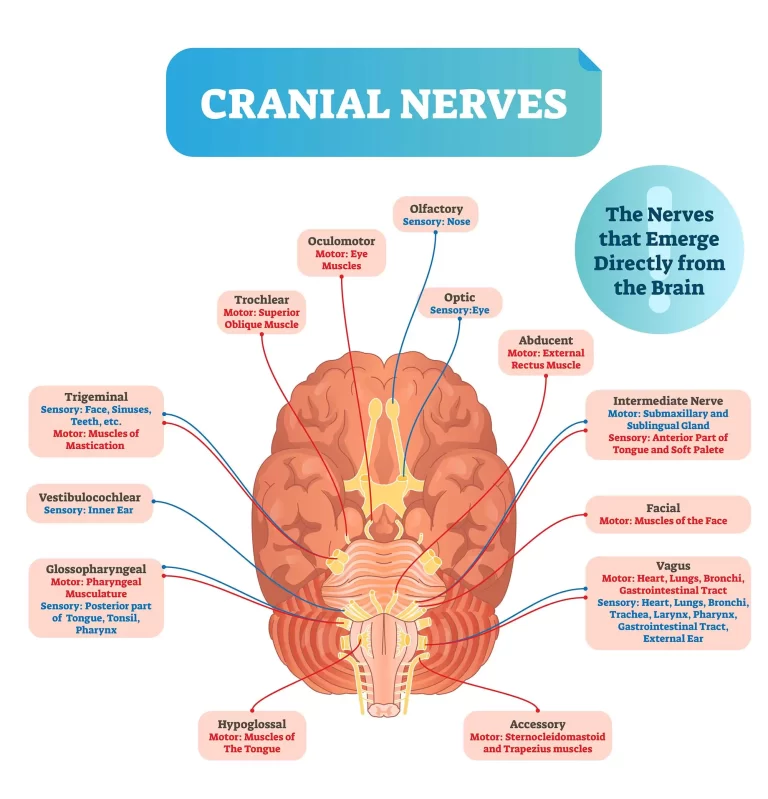
Olfactory nerves: Nerves in the nose that control smell.
Optic Nerves: Sensory nerves involved in vision.
Oculomotor, trochlear, and abducens nerves. The motor nerves that control voluntary eye movement are the
Vestibulocochlear Nerves: Sensory nerves involved in balance, orientation, orientation and hearing.
glossopharynx And hypoglossus. Tongue Movements and the sense of taste are controlled by sensory and motor nerves.
Vagus Nerves: Autonomic processes such as breathing and heart rate are controlled by Both sensory and motor nerves at the base of the head, throat, neck, chest, and abdomen.
Spinal accessory Nerves: The movement of the head, neck, and shoulder muscles is controlled by both sensory and motor nerves. Facial sensory and motor neurons control facial emotions and taste.
Trigeminal Nerves: Sensory and Motor nerves carry impulses from the lower jaw, eyes, teeth, face, and muscles of mastication. Conditions of The peripheral nervous system.
- Peripheral nervous system and impairments can result from various diseases and disorders That can cause various symptoms and difficulties, including sensory and motor processes.
Here are some Diseases that can affect the PNS:
ALS is a progressive neurological disease that damages motor neurons and causes paralysis, muscle weakness, and difficulty speaking, swallowing, and breathing.
Carpal tunnel syndrome: Pain, tingling, and Weakness in the hand and fingers caused by compression of the median nerve at the wrist.
Diabetes: Uncontrolled long-term diabetes can cause peripheral neuropathy, which can cause pain, tingling, and Numbness in the extremities.
Epstein-Barr virus: In rare cases, this viral infection can cause nerve irritation and neurological symptoms.
Guillain-Barre syndrome is an autoimmune disease in which the immune system attacks the peripheral nerves, causing weakness, numbness, and paralysis. It often starts in the feet and moves up.
lupus Inflammation Of the peripheral nerves caused by inflammation can cause a variety of neurological problems.
Peripheral neuropathy is the general name for conditions that damage the peripheral nerves and cause Symptoms such as numbness, tingling, and weakness.
Traumatic damage to peripheral nerves can impair Sensation and muscle function in the affected area.
Rheumatoid arthritis: An inflammatory condition that can cause nerve inflammation or compression, causing pain and numbness.
Compression of blood vessels or nerves in the upper chest causes thoracic outlet syndrome, which Manifests as arm discomfort, tingling, and weakness.
Tumors: Tumors can compress or damage peripheral Nerves, causing various neurological symptoms. Vitamin deficiency: Peripheral neuropathy and other Nervous system problems can be caused by a lack of certain vitamins, such as B vitamins.
General symptoms of disorders affecting the peripheral nervous system
The exact types of nerves that are affected by problems with the peripheral nervous system are strongly Related to the symptoms that result from those problems.
Signs and symptoms:
Damaged motor neurons can affect the muscles and cause the following signs and symptoms:
Weakness: Affected muscles may become weaker and harder to control. Uncontrolled muscle contractions Or movements can cause spasms, convulsions, tremors, or twitchings, which are uncomfortable, involuntary Tremors. If the muscles are not stimulated enough, muscle contraction or atrophy can occur.
Loss of control: It may be difficult to control certain muscles or make precise movements.
However, damage to sensory Nerves causes certain symptoms, including:
- Little or no sense of absence: The affected area may have a reduced sense of touch, which may result in a Lack of sensation when wearing gloves or sensitivity to heat and vibration. Simple activities like walking or Buttoning a shirt can become difficult if the arms or legs are injured. Tingling or Numbness (Paraesthesia): This sensation is similar to a “tender” feeling in an arm or leg and is often described as “pins and needles” in The affected area. Nerve pain, also known as neuropathic pain, is characterized by a burning or tingling sensation near the injured area. It can be severe enough to interfere with daily activities or sleep. Conditions Such as allodynia can make even the gentle touch of soft surfaces such as objects such as clothing or Bedding painful. Damage to the autonomic nerves can affect several organs and systems, including:
- Circulatory system: Damage to the autonomic nerves can impair the body’s control over blood pressure, Causing fluctuations in blood pressure. Digestive system: Autonomic nerve damage can make it difficult to Digest food, depending on where the damage is in the digestive system.
- Skin and temperature control: People with autonomic nerve damage may have difficulty controlling their body temperature, making it difficult to feel comfortable in hot situations. They may also have anhidrosis or Hyperhidrosis, both signs of excessive or insufficient sweating.
Diagnosis of peripheral nerve system Diseases
There are several diagnostic methods to detect diseases of the peripheral nervous system. The first step usually involves a thorough neurological examination, during which the doctor evaluates several parts of Your body, focusing especially on the hands, arms, legs, and feet.
Several typical diagnostic procedures include:
Blood tests can help detect various diseases, such as immune system problems and exposure to poisons And toxins, especially heavy metals such as mercury or lead.
Nerve conduction tests: These tests measure The speed and efficiency of nerve impulses as they travel along certain nerves. This test detects Compression or nerve damage. The electrical movement of the muscle is assessed with an
Electromyogram (EMG). It aids in the analysis of neuromuscular conditions and in determining if there is nerve damage or Muscle dysfunction.
Ultrasound of the nerves: This non-invasive imaging method employs sound waves to see and evaluate Peripheral nerves, assisting in the identification of anomalies or compressions.
Nerve Biopsy: A nerve biopsy is a procedure that examines a tiny sample of nerve tissue under a Microscope. This aids in the diagnosis of ailments that have a cellular impact on the nerves.
Genetic Testing: Genetic testing can find hereditary diseases or genetic mutations that could be responsible for illnesses of The peripheral nervous system.
Magnetic resonance imaging (MRI): MRI scans produce fine images of the Nervous system that can be used to detect tumors, hernias, structural abnormalities, and other conditions That can affect the nerves.
Peripheral nervous systems, which are often treated
As varied as the diseases themselves, there are many different ways to treat problems with the peripheral Nervous system. Often, treating the root causes of these problems can reduce their impact on the Neurological system. What works for one problem may not work for another, so it’s important to understand That different conditions may require tailored and specific treatments.
Treatment
Many different methods can be used as possible treatments, including but not limited to:
Medications
Various medications are available to treat peripheral nervous system problems. These Medications can be given as injections, oral versions, or slow-release patches, depending on the problem And its severity.
Surgery
In some cases, surgical procedures may be necessary to repair severed nerves or relieve pain Caused by trapped nerves. Transcutaneous Electrical Nerve Stimulation (TENS): This procedure uses a small electric current to block the nerves’ ability to transmit pain signals, thereby relieving discomfort. Ablation of dysfunctional nerves: By blocking the nerve from sending the wrong signal to the brain, nerve Ablation can be used to relieve chronic pain under certain conditions.
Physiotherapy Treatment
Physiotherapy is essential to speed up recovery after injuries or medical procedures. It can also help with pain relief. In addition, it helps people regain movement and function and adapt to changes in Their neurological systems.
Acupuncture: This ancient Chinese technique, which involves inserting small needles into specific points on The body, is used more often in modern medicine. Medical professionals, especially anesthesiologists and Pain management specialists, sometimes prescribe acupuncture to treat a variety of neurological conditions. Assistive devices and wearables: For people with peripheral nervous system problems, medical assistive Devices such as braces, canes, walkers, and prescription shoes can provide mobility and assistance. Illness prevention in the peripheral nervous system
Prevention
It is essential for various diseases affecting the peripheral nervous system. By taking preventive Measures, you can significantly reduce the likelihood of these problems.
- Maintain a Balanced Diet: A healthy overall diet that includes the neurological system is crucial. Make sure You get enough nutrients, especially vitamin B12, which is essential for your nerve health. Conversely, limit Your intake of certain vitamins, such as vitamin B6, as excessive amounts can be toxic and cause peripheral Neuropathy. Maintain an active lifestyle and control your weight: Regular exercise not only improves general Well-being but also helps prevent accidents that can cause nerve damage. To prevent type 2 diabetes, Which can eventually damage the peripheral nerves, it is important to maintain a healthy weight. Use safety Equipment Use proper safety equipment at work and play to protect yourself from accidents that can cause Nerve damage. This precaution can prevent or reduce the severity of potential injuries. Treatable Chronic Conditions:
- If you have a chronic condition that affects your peripheral nerves, such as type 2 diabetes, Follow your doctor’s instructions for treatment. Its effects on your neurological system can be minimized with The right treatment, which can also stop its progression.
Summary
In summary, the Peripheral Nervous System plays a crucial role in facilitating communication between the body and the brain, allowing us to perceive and respond to our surroundings while also regulating essential internal functions. It serves as a bridge that connects our sensory experiences and motor responses to the central control center of the nervous system, the Central Nervous System.
FAQs
The brain and spinal cord give rise to nerves in the peripheral nervous system. The central nervous system and many bodily parts are connected by a network of nerves. The somatic nervous system and the autonomic nervous system are further subdivided into the peripheral nervous system.
The autonomic nervous system, which regulates glands and controls involuntary bodily activities, is one of the two main divisions of the peripheral nervous system. The central nervous system receives information from the ears, eyes, and skin through the somatic nervous system, which also regulates muscle movement.
The peripheral nervous system is the organs of the nerves and ganglia. Nerves are made up of bundles of nerve fibers, much like muscles are. Spinal and cranial nerves link peripheral organs, such as muscles and glands, to the central nervous system.
The PNS’s four main responsibilities are to:
control the body’s autonomic processes.
Exercise motor control.
Digestion.
relay sensory data to the brain and spinal cord.
Both external and endogenous blood supply systems are present in peripheral nerves. The exogenous blood-supply system, which is found on loose connective tissues near nerves and the epineurium, is made up of muscle blood vessels as well as tiny arteries and veins from the surrounding tissue space.
Reference
Mba, J. C. M. (n.d.).Overview, Gross Anatomy, and Microscopic Anatomy of the Peripheral Nervous System. https://emedicine.medscape.com/article/1948687-overview
Peripheral nervous system. (2023, August 7). In Wikipedia. https://en.wikipedia.org/wiki/Peripheral_nervous_system
The Peripheral Nervous System | SEER Training. (n.d.). https://training.seer.cancer.gov/anatomy/nervous/organization/pns.html
Peripheral nervous system. (2022, July 12). Queensland University’s Queensland Brain Institute.
https://qbi.uq.edu.au/brain/brain-anatomy/peripheral-nervous-system
Vaghela, D. (2023, July 31). Peripheral Nervous System. Mobile Physiotherapy Clinic.

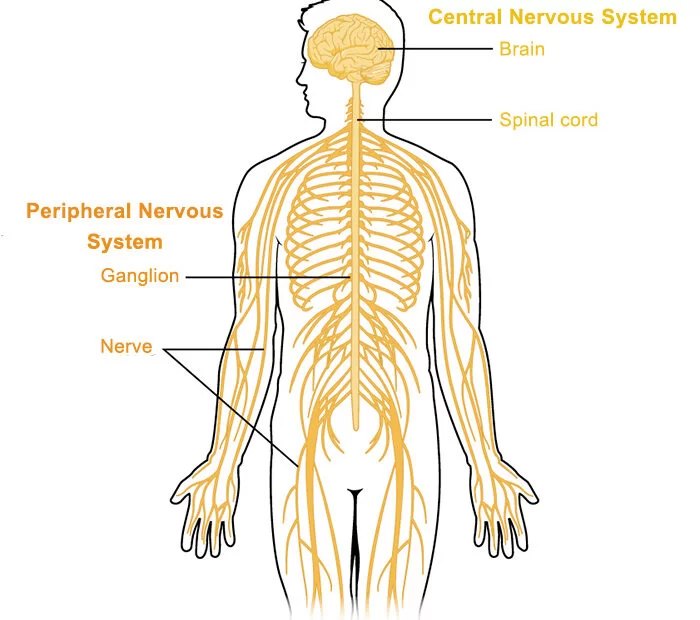

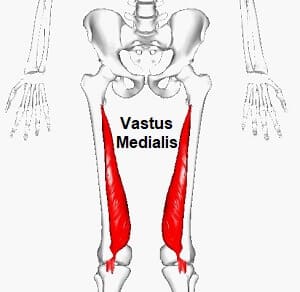
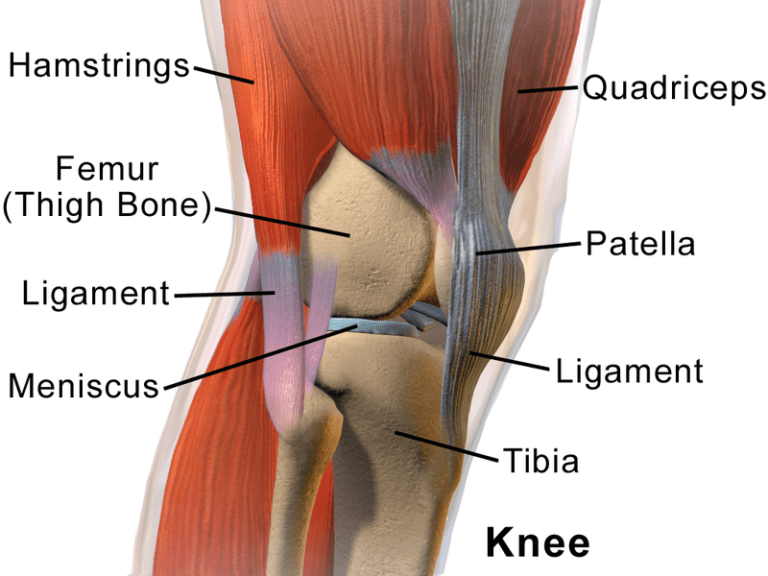
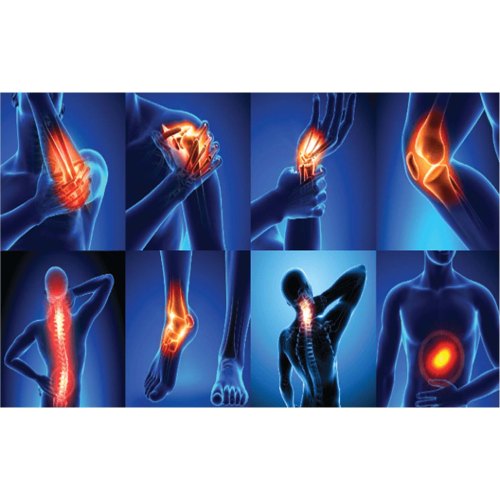
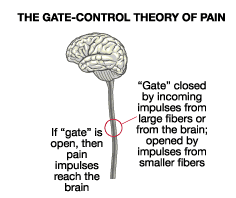
6 Comments